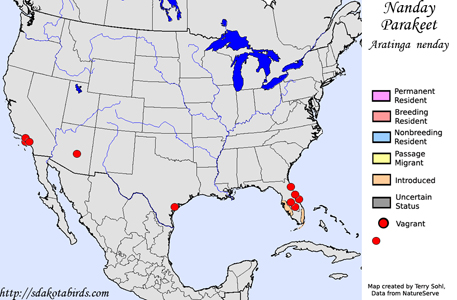| Length: 12.5 to 14.5 inches | Wingspan: 22 to 24 inches | Seasonality: Non-resident in South Dakota |
| ID Keys: Bright green overall, black head and beak, blue-green on upper chest, ,wing and tail with dark blue tips, red "leggings" | ||
 The
Nanday Parakeet, known as the Black-headed Parakeet until the American
Ornithological Union changed its official name in 2014, is a small parrot
native to South America. They have sometimes been popular as a caged pet,
and escaped cage birds have established populations in several parts of the
United States. The American Birding Association now considers the
Nanday Parakeet to be an established resident in Florida, where populations
are primarily found in and around the Miami and Tampa/St. Petersburg areas,
but they are become more widely distributed across the state. Populations
also seem to be established in Los Angeles and they are also occasionally
seen in other major cities of the far southern U.S.
The
Nanday Parakeet, known as the Black-headed Parakeet until the American
Ornithological Union changed its official name in 2014, is a small parrot
native to South America. They have sometimes been popular as a caged pet,
and escaped cage birds have established populations in several parts of the
United States. The American Birding Association now considers the
Nanday Parakeet to be an established resident in Florida, where populations
are primarily found in and around the Miami and Tampa/St. Petersburg areas,
but they are become more widely distributed across the state. Populations
also seem to be established in Los Angeles and they are also occasionally
seen in other major cities of the far southern U.S.
Habitat: Found in a variety of habitats in their native range in South America, including second-growth forest, forest and woodland edges, and riparian areas, as well as more open habitats such as agricultural lands, shrublands, or pasturelands. In their range in the United States, they are quite at home in suburban settings with well-established landscape plants, preferring areas where fruits and nuts are available.
Diet: Feeds on a wide variety of items, including fruits and berries, nuts, seeds, flowers, nectar, and fresh shoots and buds of certain plants.
Behavior: They are very gregarious outside of the breeding season. They will often form large foraging flocks, flocks that are semi-nomadic as the move from location to location in search of foraging opportunities.
Nesting: The nest of a Nanday Parakeet is a cavity in a tree. The female lays between 2 and 5 eggs. She alone incubates them, while the male delivers food during the incubation period. The eggs hatch after about 25 days.
Song: A variety of loud, shrill, screeching calls.
Migration: Considered a permanent resident throughout its normal range in South America. Populations that have become established in the United States are also considered permanent residents.
Interactive eBird map: Click here to access an interactive eBird map of Nanday Parakeet sightings
Feeders: Nanday Parakeets found in suburban settings in the U.S. have become accustomed to attending feeders for various seeds, nuts, and fruits.
Similar Species: For parrot species that have become established in the United States, Nanday Parakeets are rather distinctive in appearance, and are unlikely to be confused with another species if they are seen well.
Conservation Status: In their native range in South America, numbers are on the increase (as they are for introduced populations in the United States). They are found across a wide geographic area, and are common in parts of their range. The IUCN lists the Nanday Parakeet as a species of "Least Concern". They are persecuted as perceived agricultural pests in some parts of their native range, however.
Further Information: 1) Whatbird - Nanday Parakeet
2) Audubon - Nanday Parakeet
3) EarthsFriends - Nanday Parakeet
Photo Information: Photo by Bernard Dupont - Photo licensed under Creative Commons Attribution ShareAlike 2.0 Generic License
| Click below for a higher-resolution map |
 |
| South Dakota Status: Non-resident in South Dakota |
Additional Nanday Parakeet Photos (coming soon!!)
